window SKODA OCTAVIA 2011 2.G / (1Z) Columbus Navigation System Manual
[x] Cancel search | Manufacturer: SKODA, Model Year: 2011, Model line: OCTAVIA, Model: SKODA OCTAVIA 2011 2.G / (1Z)Pages: 47, PDF Size: 1.09 MB
Page 8 of 47
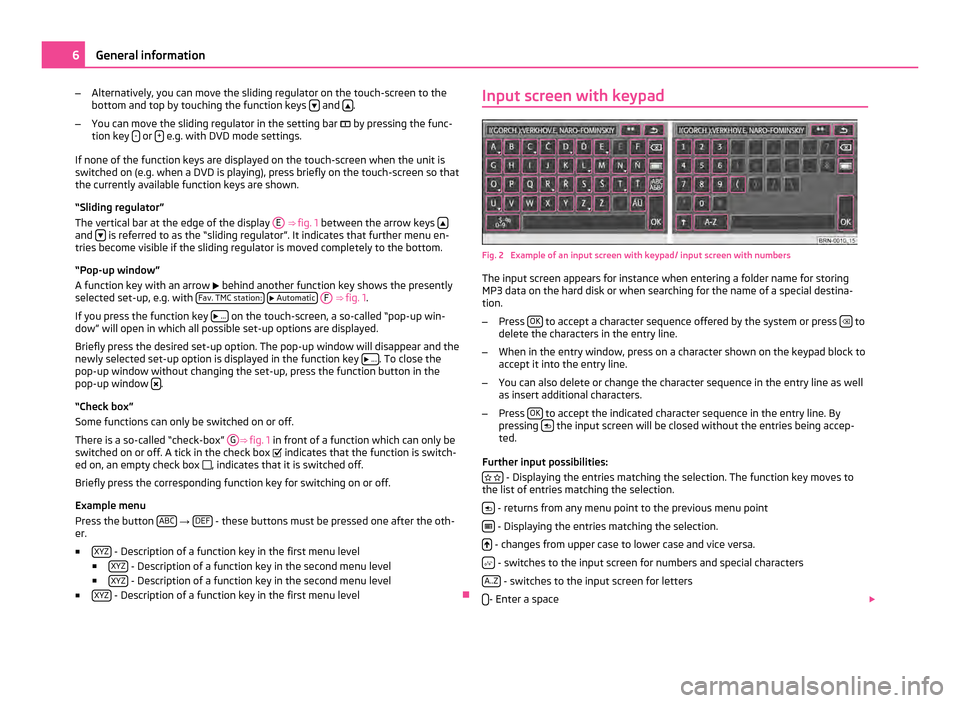
–
Alternatively, you can move the sliding regulator on the touch-screen to the
bottom and top by touching the function keys and
.
– You can move the sliding regulator in the setting bar by pressing the func-
tion key - or
+ e.g. with DVD mode settings.
If none of the function keys are displayed on the touch-screen when the unit is
switched on (e.g. when a DVD is playing), press briefly on the touch-screen so that
the currently available function keys are shown.
“
Sliding regulator”
The vertical bar at the edge of the display E ⇒ fig. 1
between the arrow keys and
is referred to as the “sliding regulator”. It indicates that further menu en-
tries become visible if the sliding regulator is moved completely to the bottom.
“Pop-up window”
A function key with an arrow behind another function key shows the presently
selected set-up, e.g. with Fav. TMC station:
Automatic
F
⇒
fig. 1 .
If you press the function key
... on the touch-screen, a so-called “pop-up win-
dow” will open in which all possible set-up options are displayed.
Briefly press the desired set-up option. The pop-up window will disappear and the
newly selected set-up option is displayed in the function key
... . To close the
pop-up window without changing the set-up, press the function button in the
pop-up window .
“Check box
”
Some functions can only be switched on or off.
There is a so-called “check-box” G ⇒
fig. 1 in front of a function which can only be
switched on or off. A tick in the check box indicates that the function is switch-
ed on, an empty check box , indicates that it is switched off.
Briefly press the corresponding function key for switching on or off.
Example menu
Press the button ABC →
DEF - these buttons must be pressed one after the oth-
er.
■ XYZ - Description of a function key in the first menu level
■ XYZ - Description of a function key in the second menu level
■ XYZ - Description of a function key in the second menu level
■ XYZ - Description of a function key in the first menu level
ÐInput screen with keypad
Fig. 2 Example of an input screen with keypad/ input screen with numbers
The input screen appears for instance when entering a folder name for storing
MP3 data on the hard disk or when searching for the name of a special destina-
tion.
– Press OK to accept a character sequence offered by the system or press
to
delete the characters in the entry line.
– When in the entry window, press on a character shown on the keypad block to
accept it into the entry line.
– You can also delete or change the character sequence in the entry line as well
as insert additional characters.
– Press OK to accept the indicated character sequence in the entry line. By
pressing the input screen will be closed without the entries being accep-
ted.
Further input possibilities: - Displaying the entries matching the selection. The function key moves to
the list of entries matching the selection.
- returns from any menu point to the previous menu point
- Displaying the entries matching the selection.
- changes from upper case to lower case and vice versa.
- switches to the input screen for numbers and special characters
A..Z - switches to the input screen for letters
- Enter a space
6
General information
Page 10 of 47
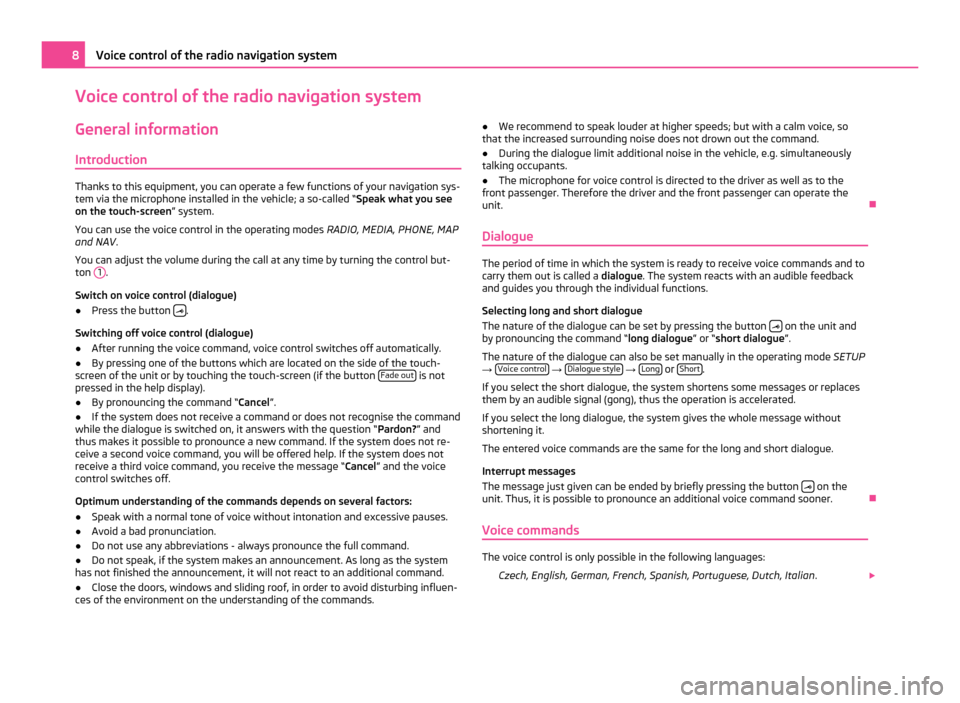
Voice control of the radio navigation system
General information
Introduction Thanks to this equipment, you can operate a few functions of your navigation sys-
tem via the microphone installed in the vehicle; a so-called “Speak what you see
on the touch-screen” system.
You can use the voice control in the operating modes RADIO, MEDIA, PHONE, MAP
and NAV .
You can adjust the volume during the call at any time by turning the control but-
ton 1 .
Switch on voice control (dialogue)
● Press the button .
Switching off voice control (dialogue)
● After running the voice command, voice control switches off automatically.
● By pressing one of the buttons which are located on the side of the touch-
screen of the unit or by touching the touch-screen (if the button Fade out is not
pressed in the help display).
● By pronouncing the command “Cancel ”.
● If the system does not receive a command or does not recognise the command
while the dialogue is switched on, it answers with the question
“Pardon?” and
thus makes it possible to pronounce a new command. If the system does not re-
ceive a second voice command, you will be offered help. If the system does not
receive a third voice command, you receive the message “ Cancel” and the voice
control switches off.
Optimum understanding of the commands depends on several factors:
● Speak with a normal tone of voice without intonation and excessive pauses.
● Avoid a bad pronunciation.
● Do not use any abbreviations - always pronounce the full command.
● Do not speak, if the system makes an announcement. As long as the system
has not finished the announcement, it will not react to an additional command.
● Close the doors, windows and sliding roof, in order to avoid disturbing influen-
ces of the environment on the understanding of the commands. ●
We recommend to speak louder at higher speeds; but with a calm voice, so
that the increased surrounding noise does not drown out the command.
● During the dialogue limit additional noise in the vehicle, e.g. simultaneously
talking occupants.
● The microphone for voice control is directed to the driver as well as to the
front passenger. Therefore the driver and the front passenger can operate the
unit. Ð
Dialogue The period of time in which the system is ready to receive voice commands and to
carry them out is called a
dialogue. The system reacts with an audible feedback
and guides you through the individual functions.
Selecting long and short dialogue
The nature of the dialogue can be set by pressing the button on the unit and
by pronouncing the command
“long dialogue ” or “short dialogue ”.
The nature of the dialogue can also be set manually in the operating mode SETUP
→ Voice control →
Dialogue style →
Long or
Short .
If you select the short dialogue, the system shortens some messages or replaces
them by an audible signal (gong), thus the operation is accelerated.
If you select the long dialogue, the system gives the whole message without
shortening it.
The entered voice commands are the same for the long and short dialogue.
Interrupt messages
The message just given can be ended by briefly pressing the button on the
unit. Thus, it is possible to pronounce an additional voice command sooner. Ð
Voice commands The voice control is only possible in the following languages:
Czech, English, German, French, Spanish, Portuguese, Dutch, Italian .8
Voice control of the radio navigation system
Page 11 of 47
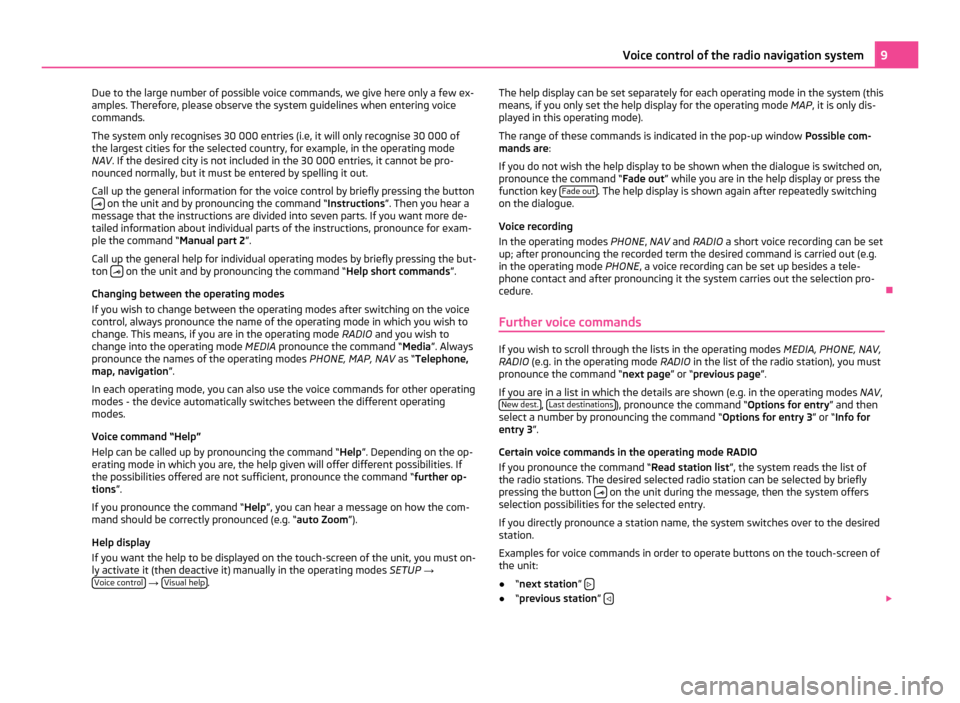
Due to the large number of possible voice commands, we give here only a few ex-
amples. Therefore, please observe the system guidelines when entering voice
commands.
The system only recognises 30 000 entries (i.e, it will only recognise 30 000 of
the largest cities for the selected country, for example, in the operating mode
NAV
. If the desired city is not included in the 30 000 entries, it cannot be pro-
nounced normally, but it must be entered by spelling it out.
Call up the general information for the voice control by briefly pressing the button on the unit and by pronouncing the command “Instructions”. Then you hear a
message that the instructions are divided into seven parts. If you want more de-
tailed information about individual parts of the instructions, pronounce for exam-
ple the command
“Manual part 2”.
Call up the general help for individual operating modes by briefly pressing the but-
ton on the unit and by pronouncing the command “Help short commands”
.
Changing between the operating modes
If you wish to change between the operating modes after switching on the voice
control, always pronounce the name of the operating mode in which you wish to
change. This means, if you are in the operating mode RADIO and you wish to
change into the operating mode MEDIA pronounce the command “Media”. Always
pronounce the names of the operating modes PHONE, MAP, NAV as “Telephone,
map, navigation ”.
In each operating mode, you can also use the voice commands for other operating
modes - the device automatically switches between the different operating
modes.
Voice command “Help”
Help can be called up by pronouncing the command “ Help”. Depending on the op-
erating mode in which you are, the help given will offer different possibilities. If
the possibilities offered are not sufficient, pronounce the command “further op-
tions”.
If you pronounce the command “Help”, you can hear a message on how the com-
mand should be correctly pronounced (e.g. “auto Zoom ”).
Help display
If you want the help to be displayed on the touch-screen of the unit, you must on-
ly activate it (then deactive it) manually in the operating modes SETUP → Voice control →
Visual help . The help display can be set separately for each operating mode in the system (this
means, if you only set the help display for the operating mode
MAP, it is only dis-
played in this operating mode).
The range of these commands is indicated in the pop-up window Possible com-
mands are:
If you do not wish the help display to be shown when the dialogue is switched on,
pronounce the command
“Fade out” while you are in the help display or press the
function key Fade out . The help display is shown again after repeatedly switching
on the dialogue.
Voice recording
In the operating modes PHONE, NAV and RADIO a short voice recording can be set
up; after pronouncing the recorded term the desired command is carried out (e.g.
in the operating mode PHONE, a voice recording can be set up besides a tele-
phone contact and after pronouncing it the system carries out the selection pro-
cedure. Ð
Further voice commands If you wish to scroll through the lists in the operating modes
MEDIA, PHONE, NAV,
RADIO (e.g. in the operating mode RADIO in the list of the radio station), you must
pronounce the command
“next page” or “previous page”.
If you are in a list in which the details are shown (e.g. in the operating modes NAV,
New dest. ,
Last destinations ), pronounce the command “Options for entry
” and then
select a number by pronouncing the command
“Options for entry 3” or “Info for
entry 3 ”.
Certain voice commands in the operating mode RADIO
If you pronounce the command “Read station list ”, the system reads the list of
the radio stations. The desired selected radio station can be selected by briefly
pressing the button on the unit during the message, then the system offers
selection possibilities for the selected entry.
If you directly pronounce a station name, the system switches over to the desired
station.
Examples for voice commands in order to operate buttons on the touch-screen of
the unit:
● “next station ” ●
“previous station” 9
Voice control of the radio navigation system
Page 19 of 47
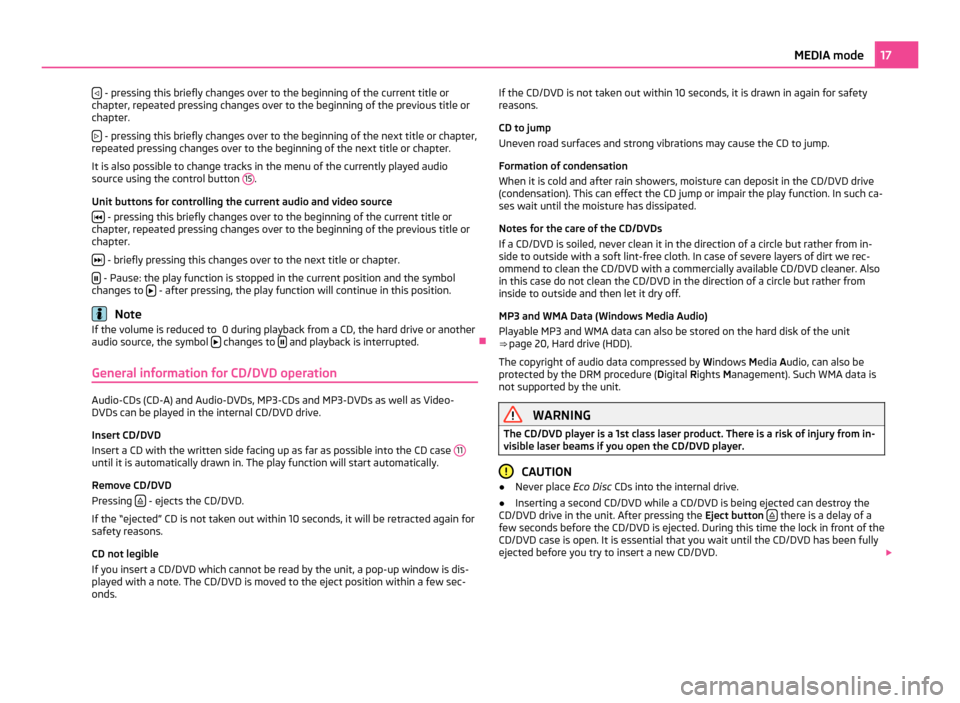
- pressing this briefly changes over to the beginning of the current title or
chapter, repeated pressing changes over to the beginning of the previous title or
chapter.
- pressing this briefly changes over to the beginning of the next title or chapter,
repeated pressing changes over to the beginning of the next title or chapter.
It is also possible to change tracks in the menu of the currently played audio
source using the control button 15 .
Unit buttons for controlling the current audio and video source - pressing this briefly changes over to the beginning of the current title or
chapter, repeated pressing changes over to the beginning of the previous title or
chapter.
- briefly pressing this changes over to the next title or chapter.
- Pause: the play function is stopped in the current position and the symbol
changes to - after pressing, the play function will continue in this position.
Note
If the volume is reduced to 0 during playback from a CD, the hard drive or another
audio source, the symbol changes to
and playback is interrupted.
Ð
General information for CD/DVD operation Audio-CDs (CD-A) and Audio-DVDs, MP3-CDs and MP3-DVDs as well as Video-
DVDs can be played in the internal CD/DVD drive.
Insert CD/DVD
Insert a CD with the written side facing up as far as possible into the CD case
11until it is automatically drawn in. The play function will start automatically.
Remove CD/DVD
Pressing
- ejects the CD/DVD.
If the
“ejected” CD is not taken out within 10 seconds, it will be retracted again for
safety reasons.
CD not legible
If you insert a CD/DVD which cannot be read by the unit, a pop-up window is dis-
played with a note. The CD/DVD is moved to the eject position within a few sec-
onds. If the CD/DVD is not taken out within 10 seconds, it is drawn in again for safety
reasons.
CD to jump
Uneven road surfaces and strong vibrations may cause the CD to jump.
Formation of condensation
When it is cold and after rain showers, moisture can deposit in the CD/DVD drive
(condensation). This can effect the CD jump or impair the play function. In such ca-
ses wait until the moisture has dissipated.
Notes for the care of the CD/DVDs
If a CD/DVD is soiled, never clean it in the direction of a circle but rather from in-
side to outside with a soft lint-free cloth. In case of severe layers of dirt we rec-
ommend to clean the CD/DVD with a commercially available CD/DVD cleaner. Also
in this case do not clean the CD/DVD in the direction of a circle but rather from
inside to outside and then let it dry off.
MP3 and WMA Data (Windows Media Audio)
Playable MP3 and WMA data can also be stored on the hard disk of the unit
⇒
page 20, Hard drive (HDD).
The copyright of audio data compressed by Windows Media Audio, can also be
protected by the DRM procedure ( Digital Rights Management). Such WMA data is
not supported by the unit. WARNING
The CD/DVD player is a 1st class laser product. There is a risk of injury from in-
visible laser beams if you open the CD/DVD player. CAUTION
● Never place Eco Disc CDs into the internal drive.
● Inserting a second CD/DVD while a CD/DVD is being ejected can destroy the
CD/DVD drive in the unit. After pressing the Eject button there is a delay of a
few seconds before the CD/DVD is ejected. During this time the lock in front of the
CD/DVD case is open. It is essential that you wait until the CD/DVD has been fully
ejected before you try to insert a new CD/DVD. 17
MEDIA mode
Page 20 of 47
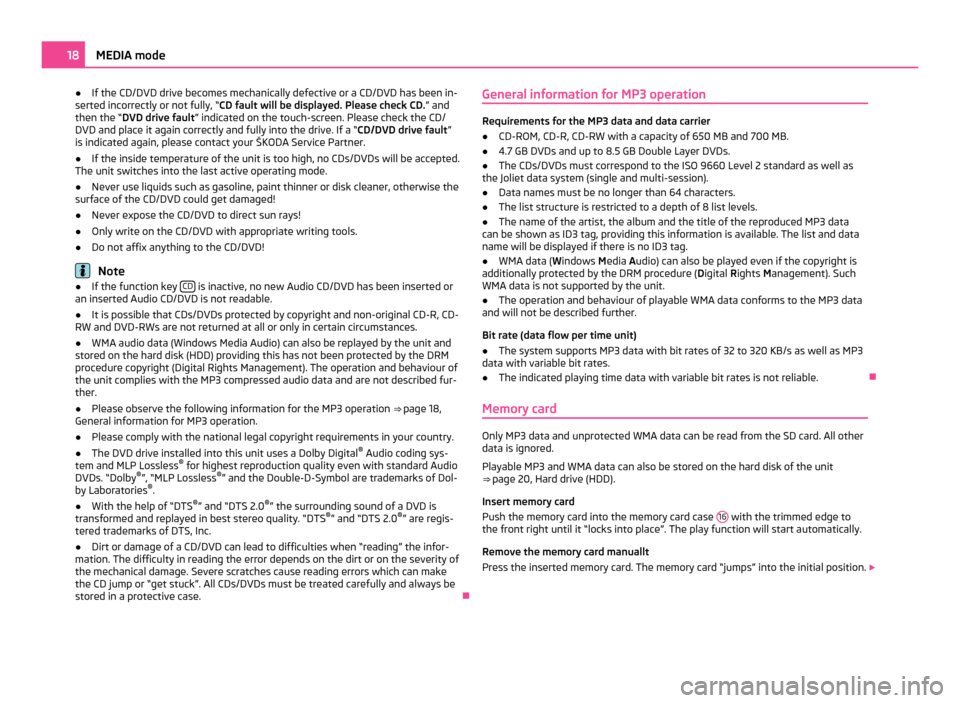
●
If the CD/DVD drive becomes mechanically defective or a CD/DVD has been in-
serted incorrectly or not fully, “CD fault will be displayed. Please check CD. ” and
then the “DVD drive fault ” indicated on the touch-screen. Please check the CD/
DVD and place it again correctly and fully into the drive. If a “CD/DVD drive fault ”
is indicated again, please contact your ŠKODA Service Partner.
● If the inside temperature of the unit is too high, no CDs/DVDs will be accepted.
The unit switches into the last active operating mode.
● Never use liquids such as gasoline, paint thinner or disk cleaner, otherwise the
surface of the CD/DVD could get damaged!
● Never expose the CD/DVD to direct sun rays!
● Only write on the CD/DVD with appropriate writing tools.
● Do not affix anything to the CD/DVD! Note
● If the function key CD is inactive, no new Audio CD/DVD has been inserted or
an inserted Audio CD/DVD is not readable.
● It is possible that CDs/DVDs protected by copyright and non-original CD-R, CD-
RW and DVD-RWs are not returned at all or only in certain circumstances.
● WMA audio data (Windows Media Audio) can also be replayed by the unit and
stored on the hard disk (HDD) providing this has not been protected by the DRM
procedure copyright (Digital Rights Management). The operation and behaviour of
the unit complies with the MP3 compressed audio data and are not described fur-
ther.
● Please observe the following information for the MP3 operation ⇒ page 18,
General information for MP3 operation
.
● Please comply with the national legal copyright requirements in your country.
● The DVD drive installed into this unit uses a Dolby Digital ®
Audio coding sys-
tem and MLP Lossless ®
for highest reproduction quality even with standard Audio
DVDs.
“Dolby ®
”, “MLP Lossless ®
” and the Double-D-Symbol are trademarks of Dol-
by Laboratories ®
.
● With the help of “DTS ®
” and “DTS 2.0 ®
” the surrounding sound of a DVD is
transformed and replayed in best stereo quality.
“DTS®
” and “DTS 2.0 ®
” are regis-
tered trademarks of DTS, Inc.
● Dirt or damage of a CD/DVD can lead to difficulties when “reading” the infor-
mation. The difficulty in reading the error depends on the dirt or on the severity of
the mechanical damage. Severe scratches cause reading errors which can make
the CD jump or
“get stuck”. All CDs/DVDs must be treated carefully and always be
stored in a protective case. ÐGeneral information for MP3 operation Requirements for the MP3 data and data carrier
●
CD-ROM, CD-R, CD-RW with a capacity of 650 MB and 700 MB.
● 4.7 GB DVDs and up to 8.5 GB Double Layer DVDs.
● The CDs/DVDs must correspond to the ISO 9660 Level 2 standard as well as
the Joliet data system (single and multi-session).
● Data names must be no longer than 64 characters.
● The list structure is restricted to a depth of 8 list levels.
● The name of the artist, the album and the title of the reproduced MP3 data
can be shown as ID3 tag, providing this information is available. The list and data
name will be displayed if there is no ID3 tag.
● WMA data ( Windows Media Audio) can also be played even if the copyright is
additionally protected by the DRM procedure ( Digital Rights Management). Such
WMA data is not supported by the unit.
● The operation and behaviour of playable WMA data conforms to the MP3 data
and will not be described further.
Bit rate (data flow per time unit)
● The system supports MP3 data with bit rates of 32 to 320 KB/s as well as MP3
data with variable bit rates.
● The indicated playing time data with variable bit rates is not reliable. Ð
Memory card Only MP3 data and unprotected WMA data can be read from the SD card. All other
data is ignored.
Playable MP3 and WMA data can also be stored on the hard disk of the unit
⇒ page 20, Hard drive (HDD)
.
Insert memory card
Push the memory card into the memory card case 16 with the trimmed edge to
the front right until it
“locks into place”. The play function will start automatically.
Remove the memory card manuallt
Press the inserted memory card. The memory card “jumps” into the initial position. 18
MEDIA mode
Page 40 of 47
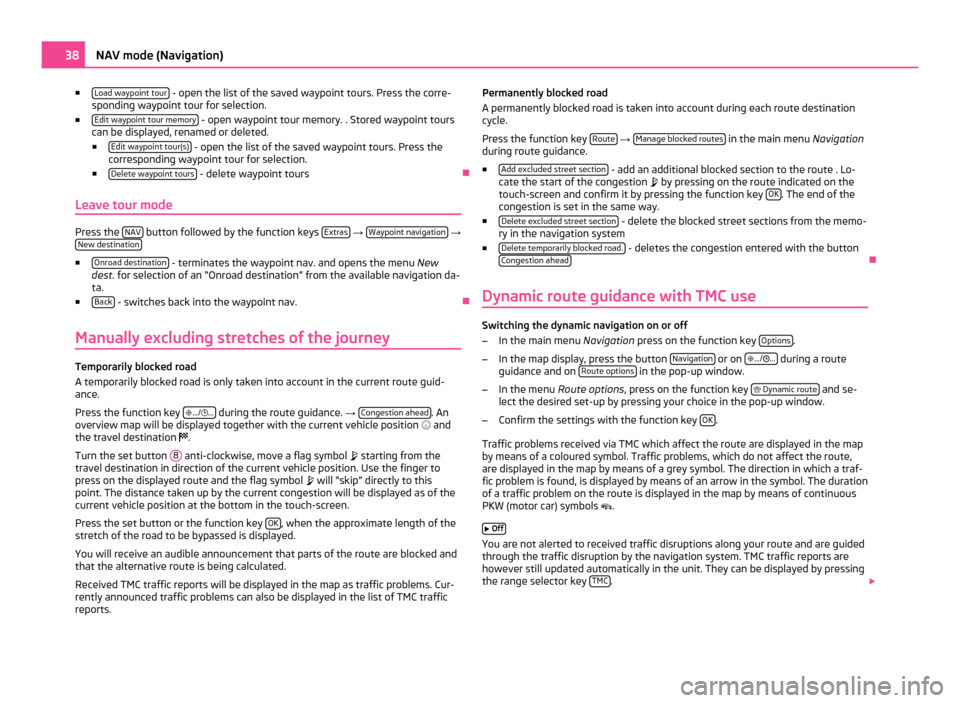
■
Load waypoint tour - open the list of the saved waypoint tours. Press the corre-
sponding waypoint tour for selection.
■ Edit waypoint tour memory - open waypoint tour memory. . Stored waypoint tours
can be displayed, renamed or deleted.
■ Edit waypoint tour(s) - open the list of the saved waypoint tours. Press the
corresponding waypoint tour for selection.
■ Delete waypoint tours - delete waypoint tours
Ð
Leave tour mode Press the
NAV button followed by the function keys
Extras →
Waypoint navigation →
New destination ■
Onroad destination - terminates the waypoint nav. and opens the menu
New
dest. for selection of an “Onroad destination ” from the available navigation da-
ta.
■ Back - switches back into the waypoint nav.
Ð
Manually excluding stretches of the journey Temporarily blocked road
A temporarily blocked road is only taken into account in the current route guid-
ance.
Press the function key
.../ ... during the route guidance.
→ Congestion ahead . An
overview map will be displayed together with the current vehicle position and
the travel destination .
Turn the set button 8 anti-clockwise, move a flag symbol
starting from the
travel destination in direction of the current vehicle position. Use the finger to
press on the displayed route and the flag symbol will
“skip” directly to this
point. The distance taken up by the current congestion will be displayed as of the
current vehicle position at the bottom in the touch-screen.
Press the set button or the function key OK , when the approximate length of the
stretch of the road to be bypassed is displayed.
You will receive an audible announcement that parts of the route are blocked and
that the alternative route is being calculated.
Received TMC traffic reports will be displayed in the map as traffic problems. Cur-
rently announced traffic problems can also be displayed in the list of TMC traffic
reports. Permanently blocked road
A permanently blocked road is taken into account during each route destination
cycle.
Press the function key
Route →
Manage blocked routes in the main menu
Navigation
during route guidance.
■ Add excluded street section - add an additional blocked section to the route . Lo-
cate the start of the congestion by pressing on the route indicated on the
touch-screen and confirm it by pressing the function key OK . The end of the
congestion is set in the same way.
■ Delete excluded street section - delete the blocked street sections from the memo-
ry in the navigation system
■ Delete temporarily blocked road. - deletes the congestion entered with the button
Congestion ahead Ð
Dynamic route guidance with TMC use Switching the dynamic navigation on or off
–
In the main menu Navigation press on the function key Options .
– In the map display, press the button Navigation or on
.../ ... during a route
guidance and on Route options in the pop-up window.
– In the menu Route options , press on the function key
Dynamic route and se-
lect the desired set-up by pressing your choice in the pop-up window.
– Confirm the settings with the function key OK .
Traffic problems received via TMC which affect the route are displayed in the map
by means of a coloured symbol. Traffic problems, which do not affect the route,
are displayed in the map by means of a grey symbol. The direction in which a traf-
fic problem is found, is displayed by means of an arrow in the symbol. The duration
of a traffic problem on the route is displayed in the map by means of continuous
PKW (motor car) symbols .
Off You are not alerted to received traffic disruptions along your route and are guided
through the traffic disruption by the navigation system. TMC traffic reports are
however still updated automatically in the unit. They can be displayed by pressing
the range selector key TMC .
38
NAV mode (Navigation)
Page 41 of 47
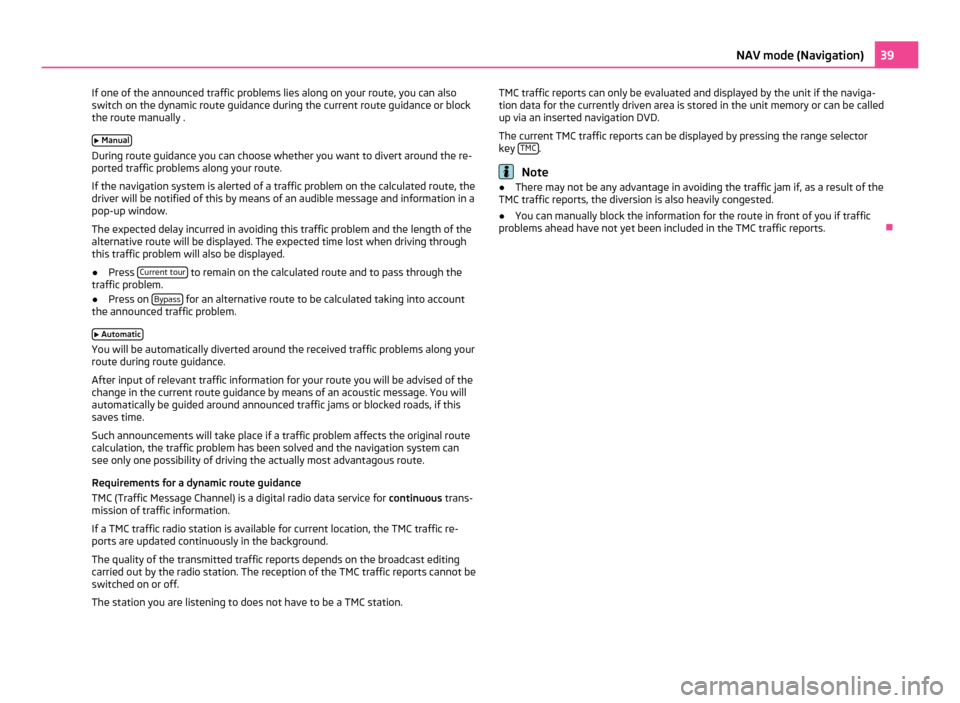
If one of the announced traffic problems lies along on your route, you can also
switch on the dynamic route guidance during the current route guidance or block
the route manually .
Manual During route guidance you can choose whether you want to divert around the re-
ported traffic problems along your route.
If the navigation system is alerted of a traffic problem on the calculated route, the
driver will be notified of this by means of an audible message and information in a
pop-up window.
The expected delay incurred in avoiding this traffic problem and the length of the
alternative route will be displayed. The expected time lost when driving through
this traffic problem will also be displayed.
● Press Current tour to remain on the calculated route and to pass through the
traffic problem.
● Press on Bypass for an alternative route to be calculated taking into account
the announced traffic problem.
Automatic You will be automatically diverted around the received traffic problems along your
route during route guidance.
After input of relevant traffic information for your route you will be advised of the
change in the current route guidance by means of an acoustic message. You will
automatically be guided around announced traffic jams or blocked roads, if this
saves time.
Such announcements will take place if a traffic problem affects the original route
calculation, the traffic problem has been solved and the navigation system can
see only one possibility of driving the actually most advantagous route.
Requirements for a dynamic route guidance
TMC (Traffic Message Channel) is a digital radio data service for continuous trans-
mission of traffic information.
If a TMC traffic radio station is available for current location, the TMC traffic re-
ports are updated continuously in the background.
The quality of the transmitted traffic reports depends on the broadcast editing
carried out by the radio station. The reception of the TMC traffic reports cannot be
switched on or off.
The station you are listening to does not have to be a TMC station. TMC traffic reports can only be evaluated and displayed by the unit if the naviga-
tion data for the currently driven area is stored in the unit memory or can be called
up via an inserted navigation DVD.
The current TMC traffic reports can be displayed by pressing the range selector
key
TMC .
Note
● There may not be any advantage in avoiding the traffic jam if, as a result of the
TMC traffic reports, the diversion is also heavily congested.
● You can manually block the information for the route in front of you if traffic
problems ahead have not yet been included in the TMC traffic reports. Ð 39
NAV mode (Navigation)